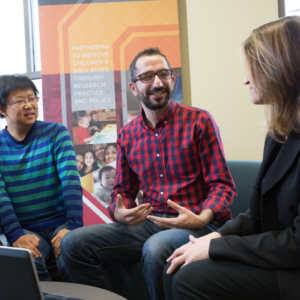A team from the Crane Center analyzed 2021-2022 state Kindergarten Readiness Assessment data and overall trends to examine the readiness of children participating in Early Start Columbus.
Our policy team shares four things that they will be paying attention to in 2021 regarding early childhood policy. They are careful to note, these are not* predictions (after what 2020 taught us about making predictions for the year).
Our Broken Child Care System and How to Fix It, Part 3: The final segment of this series examines how the many systems that make up U.S. child care are failing. Fixes that are both sweeping enough and realistic aren’t obvious, so Dr. Laura Justice turns to three experts to weigh in.
Our country’s early care and education system was fractured and in crisis, even before COVID-19. The abrupt closure of many child care centers, new requirements upon opening, and challenges facing families make it even more pressing that our “rebuilding” efforts work toward a more sustainable and equitable child care system.
Our Broken Child Care System and How to Fix It, Part 2: our executive director Dr. Laura Justice examines how child care programs are a key part of the economic infrastructure but are also developing the nation’s brain trust of the future.
In this three-part series, Dr. Laura Justice — executive director of the Crane Center for Early Childhood Research and Policy and Schoenbaum Family Center at The Ohio State University — surveys the fragmented landscape of child care in the United States, highlighting its vulnerabilities even in the best of times.
This year, we started Tuned In – our Friday morning round-up of policy-related news and analysis. It’s been a labor of love that my colleague Caitlin and I really enjoy providing to you all. In lieu of our regular edition today, here’s a reflection on nine of the best (policy-related) things that happened in 2019, in no particular order.
Last month we rounded up what we thought were the best 9 policy-related trends from 2019. Now, here are five predictions for the coming year from where we sit at our cross-section of early childhood research and policy.
This month, PDK released results from the 50th annual poll of public attitudes about public schools. The survey offers the most trusted source of opinion data on K-12 education issues ranging from school funding and teacher pay to safety and school day hours.
For early childhood advocates, the latest federal preschool development grant offers a chance for Ohio to improve the quality of programming not just in Pre-K, but in childcare programs from birth to age five.
Earlier this month, Ohio’s State Board of Education expressed its support for early childhood spending through two actions. The first was approval of a budget plan that would protect the state’s early childhood program in the event of budget cuts. The second is found in a document outlining priorities for additional funding.
Not unlike the majority of education policy, most of the decision-making power related to giftedness falls to the states. This devolution of power results in very different approaches to how gifted students are identified and served across state lines.
- 1
- 2

